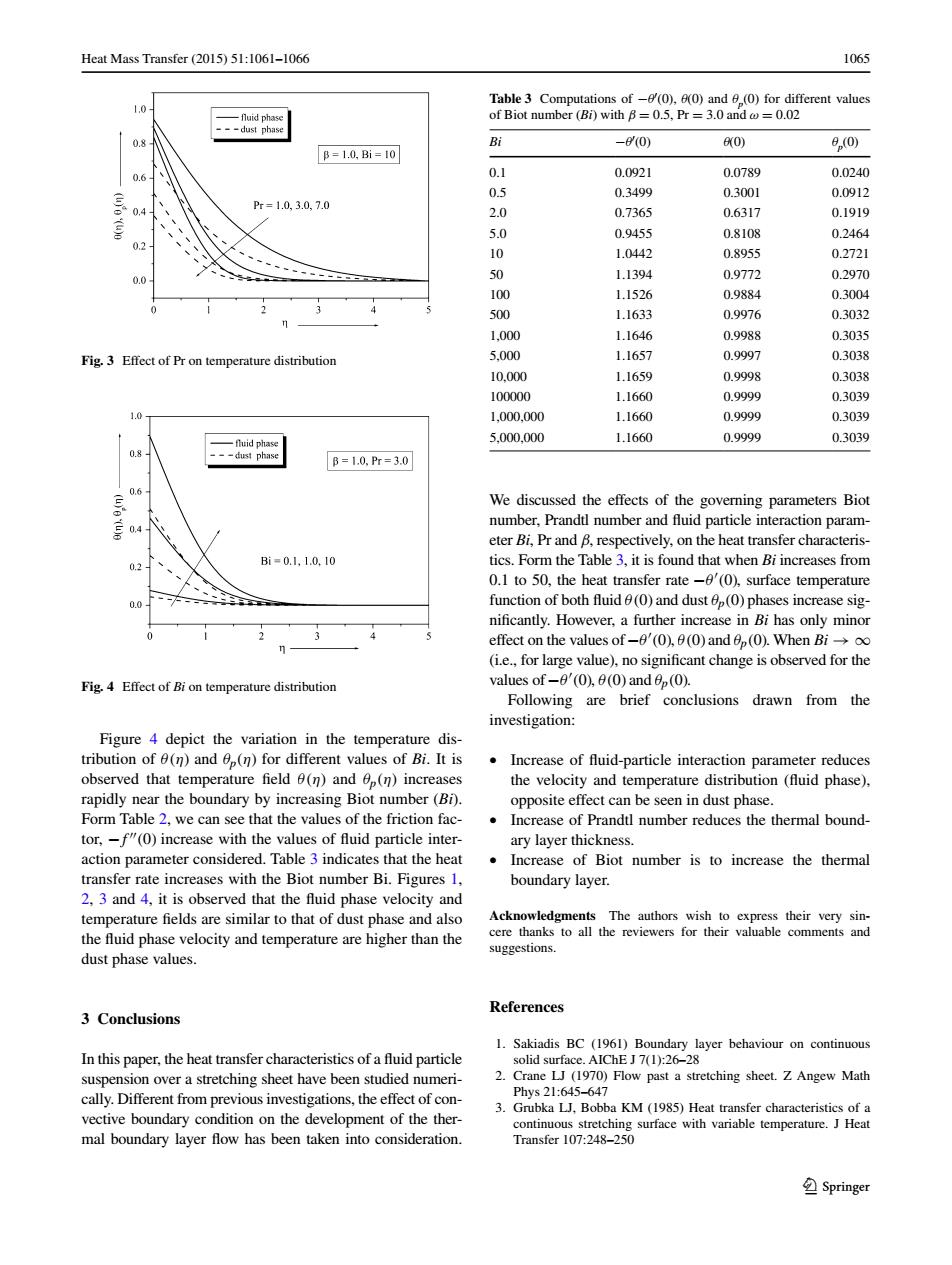正在加载图片...

Heat Mass Transfer (2015)51:1061-106 1065 (0)for different value 三因 -0 0.1 0.0921 0.0789 0.0240 0.5 0.3499 0.3001 0.0912 ((4)e =1030,70 20 0.736 0.6317 0.1919 0.9145 0.810 0.246 1.04 0.892 0.2721 0.977 0.2970 633 .000 1.1646 09988 0.3035 Fig.3 Effect of Pr on temperature distribution 5.000 11657 000g7 0.3038 10000 1.1659 0.998 0.3038 100000 1.1660 0.999 0.3039 1.0 1.000.000 1.1660 0.9999 0.303 5.000.000 1.1660 0.9999 0.3039 0-1.0.Pm-3.0 We ed the gove et Bi.Pr Bi=0L.1.0.10 tics.Form the Table 3 it is found that when Bi in ses from 0.1 to 50.the heat transfer rate-).surface temperature function of both fluid (0)and dust (0)phases increase sig nifcantly.However,a further in rease in Br has only minor effect on the valu sof-0(0(0)a dp(0).When B ant change is observed for the Fig Effect of on temperature distribution A(0 Following are cnclusions drawn from the investigation: Figure 4 depict the variation in the temperature dis tribution of()and(for different values of Bi.It is Increase of fluid-particle interaction parameter reduces tempe (an ,()incre the velocity and temperature distribution(fluid phase). the hermal bound f"(0)increase with the values of fuid particle inter layer thickne action parameter considered table 3 indicates that the heat ase of Biot number is to increase the thermal transfer rate increases with the Biot number Bi.Figures 1 boundary layer. 2.3 and 4.it is observed that the fluid phase velocity and are sin 1a o that or dust p city and temperature are higher References 3 Conclusions 1.Sakiadis BC (1961 In this paper.the of fluid partick 2.Crane LI (97 ove ng sheet nave a stretching sheet.Z Angew Math tive boundar othe development of the ther Bobba KM(1985)Heat tra mal boundary layer flow has been taken into considerationHeat Mass Transfer (2015) 51:1061–1066 1065 1 3 Figure 4 depict the variation in the temperature distribution of θ (η) and θp(η) for different values of Bi. It is observed that temperature field θ (η) and θp(η) increases rapidly near the boundary by increasing Biot number (Bi). Form Table 2, we can see that the values of the friction factor, −f ′′(0) increase with the values of fluid particle interaction parameter considered. Table 3 indicates that the heat transfer rate increases with the Biot number Bi. Figures 1, 2, 3 and 4, it is observed that the fluid phase velocity and temperature fields are similar to that of dust phase and also the fluid phase velocity and temperature are higher than the dust phase values. 3 Conclusions In this paper, the heat transfer characteristics of a fluid particle suspension over a stretching sheet have been studied numerically. Different from previous investigations, the effect of convective boundary condition on the development of the thermal boundary layer flow has been taken into consideration. We discussed the effects of the governing parameters Biot number, Prandtl number and fluid particle interaction parameter Bi, Pr and β, respectively, on the heat transfer characteristics. Form the Table 3, it is found that when Bi increases from 0.1 to 50, the heat transfer rate −θ′ (0), surface temperature function of both fluid θ (0) and dust θp(0) phases increase significantly. However, a further increase in Bi has only minor effect on the values of −θ′ (0), θ (0) and θp(0). When Bi → ∞ (i.e., for large value), no significant change is observed for the values of −θ′ (0), θ (0) and θp(0). Following are brief conclusions drawn from the investigation: • Increase of fluid-particle interaction parameter reduces the velocity and temperature distribution (fluid phase), opposite effect can be seen in dust phase. • Increase of Prandtl number reduces the thermal boundary layer thickness. • Increase of Biot number is to increase the thermal boundary layer. Acknowledgments The authors wish to express their very sincere thanks to all the reviewers for their valuable comments and suggestions. References 1. Sakiadis BC (1961) Boundary layer behaviour on continuous solid surface. AIChE J 7(1):26–28 2. Crane LJ (1970) Flow past a stretching sheet. Z Angew Math Phys 21:645–647 3. Grubka LJ, Bobba KM (1985) Heat transfer characteristics of a continuous stretching surface with variable temperature. J Heat Transfer 107:248–250 Fig. 3 Effect of Pr on temperature distribution Fig. 4 Effect of Bi on temperature distribution Table 3 Computations of −θ′(0), θ(0) and θp(0) for different values of Biot number (Bi) with β = 0.5, Pr = 3.0 and ω = 0.02 Bi −θ′(0) θ(0) θp(0) 0.1 0.0921 0.0789 0.0240 0.5 0.3499 0.3001 0.0912 2.0 0.7365 0.6317 0.1919 5.0 0.9455 0.8108 0.2464 10 1.0442 0.8955 0.2721 50 1.1394 0.9772 0.2970 100 1.1526 0.9884 0.3004 500 1.1633 0.9976 0.3032 1,000 1.1646 0.9988 0.3035 5,000 1.1657 0.9997 0.3038 10,000 1.1659 0.9998 0.3038 100000 1.1660 0.9999 0.3039 1,000,000 1.1660 0.9999 0.3039 5,000,000 1.1660 0.9999 0.3039